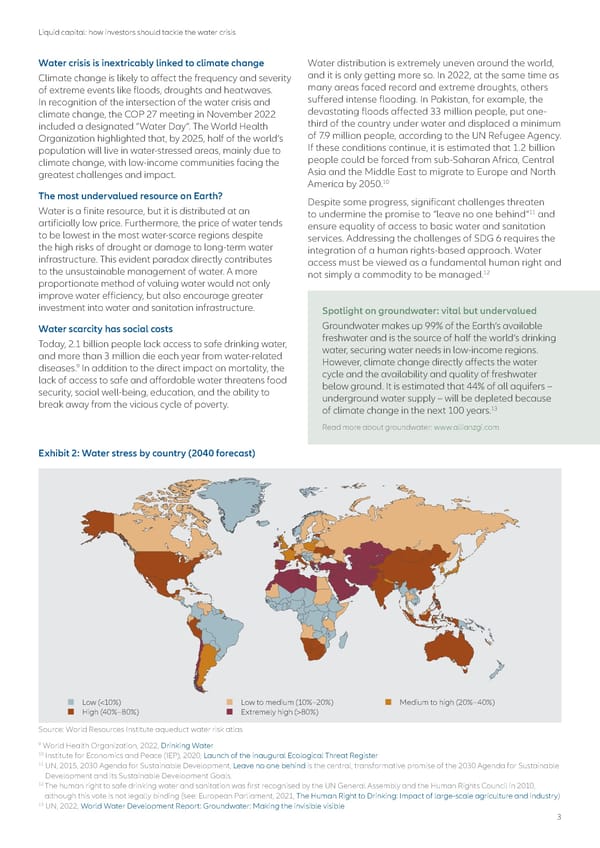Liquid capital: how investors should tackle the water crisis Water crisis is inextricably linked to climate change Water distribution is extremely uneven around the world, Climate change is likely to a昀昀ect the frequency and severity and it is only getting more so. In 2022, at the same time as of extreme events like 昀氀oods, droughts and heatwaves. many areas faced record and extreme droughts, others In recognition of the intersection of the water crisis and su昀昀ered intense 昀氀ooding. In Pakistan, for example, the climate change, the COP 27 meeting in November 2022 devastating 昀氀oods a昀昀ected 33 million people, put one- included a designated “Water Day”. The World Health third of the country under water and displaced a minimum Organization highlighted that, by 2025, half of the world’s of 7.9 million people, according to the UN Refugee Agency. population will live in water-stressed areas, mainly due to If these conditions continue, it is estimated that 1.2 billion climate change, with low-income communities facing the people could be forced from sub-Saharan Africa, Central greatest challenges and impact. Asia and the Middle East to migrate to Europe and North 10 America by 2050. The most undervalued resource on Earth? Despite some progress, signi昀椀cant challenges threaten Water is a 昀椀nite resource, but it is distributed at an 11 to undermine the promise to “leave no one behind” and arti昀椀cially low price. Furthermore, the price of water tends ensure equality of access to basic water and sanitation to be lowest in the most water-scarce regions despite services. Addressing the challenges of SDG 6 requires the the high risks of drought or damage to long-term water integration of a human rights-based approach. Water infrastructure. This evident paradox directly contributes access must be viewed as a fundamental human right and to the unsustainable management of water. A more 12 not simply a commodity to be managed. proportionate method of valuing water would not only improve water e昀케ciency, but also encourage greater investment into water and sanitation infrastructure. Spotlight on groundwater: vital but undervalued Water scarcity has social costs Groundwater makes up 99% of the Earth’s available Today, 2.1 billion people lack access to safe drinking water, freshwater and is the source of half the world’s drinking and more than 3 million die each year from water-related water, securing water needs in low-income regions. 9 However, climate change directly a昀昀ects the water diseases. In addition to the direct impact on mortality, the cycle and the availability and quality of freshwater lack of access to safe and a昀昀ordable water threatens food below ground. It is estimated that 44% of all aquifers – security, social well-being, education, and the ability to underground water supply – will be depleted because break away from the vicious cycle of poverty. 13 of climate change in the next 100 years. Read more about groundwater: www.allianzgi.com Exhibit 2: Water stress by country (2040 forecast) Low (80%) Source: World Resources Institute aqueduct water risk atlas 9 World Health Organization, 2022, Drinking Water 10 Institute for Economics and Peace (IEP), 2020, Launch of the inaugural Ecological Threat Register 11 UN, 2015, 2030 Agenda for Sustainable Development, Leave no one behind is the central, transformative promise of the 2030 Agenda for Sustainable Development and its Sustainable Development Goals. 12 The human right to safe drinking water and sanitation was 昀椀rst recognised by the UN General Assembly and the Human Rights Council in 2010, although this vote is not legally binding (see: European Parliament, 2021, The Human Right to Drinking: Impact of large-scale agriculture and industry) 13 UN, 2022, World Water Development Report: Groundwater: Making the invisible visible 3
 Liquid Capital Page 2 Page 4
Liquid Capital Page 2 Page 4